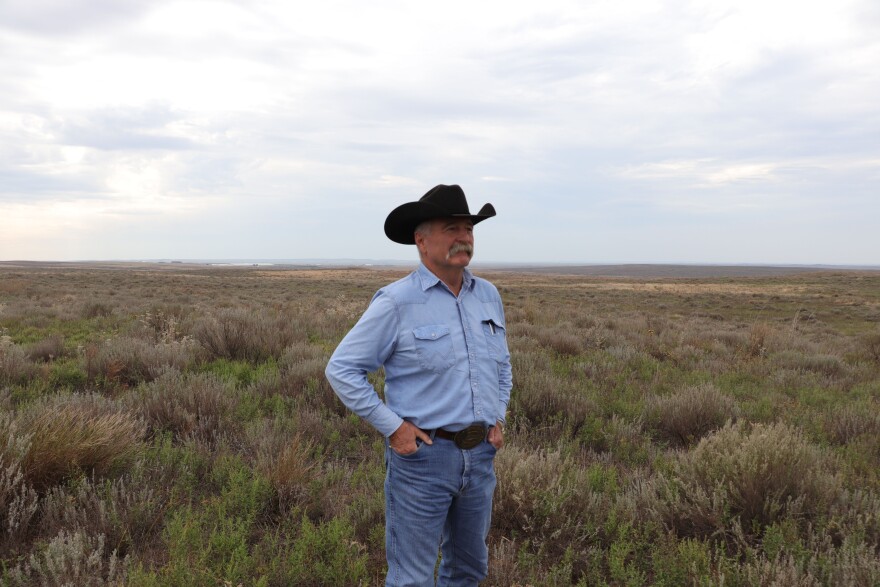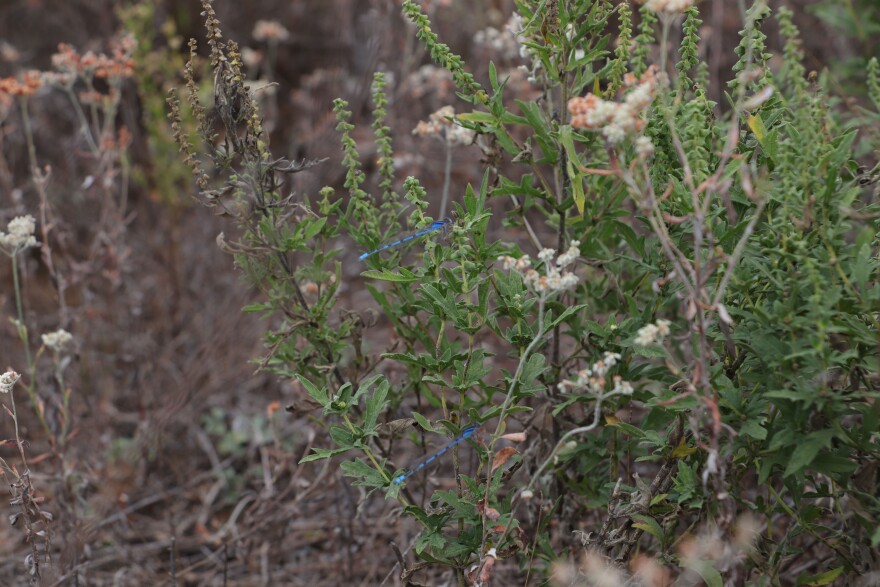In mid-October, Mark Gardiner ended a ranch tour on an elevated piece of land he calls “the high and lonesome.” The lookout near the Oklahoma-Kansas state line opens up to a sea of sagebrush prairie, a hospitable home for deer, badgers, songbirds, dragonflies and other wildlife.
Visitors of the 48,000-acre Gardiner Angus Ranch who stick around long enough may also spot a species that has been on the minds of conservationists for decades: the lesser prairie chicken.
“The reason that this is still here today is probably a byproduct of the fact that it's not very good land for farming and to raise crops on, it's too rough, it's too sandy,” Gardiner said of the parcel.

The undeveloped land is among the last remaining habitat for the lesser prairie chicken, which has seen its natural range shrink by about 90%, according to the U.S. Fish and Wildlife Service. The bird is only found in five states, including Oklahoma.
Disturbances from woody encroachment, renewable energy projects and oil and gas activity have caused some of the species’ decline.
The bird was given federal protection under the Endangered Species Act in 2014 and in 2022, but was removed in both instances.
In August, a Texas judge ruled that Fish and Wildlife made a mistake in its most recent listing, stripping the bird’s “threatened” status. The decision is meant to open more land to development, including energy and transmission infrastructure.
Yet with nearly all of the species’ range on private land, scientists and advocates have historically relied on landowners to help save the species. State workers worry the on-and-off protected status of the lesser prairie chicken has the potential to erode that trust.
“ Is it going to be listed again in the future? Is it going to be challenged? Will that remain that way?” asked Kurt Kuklinski, wildlife research and diversity supervisor for the Oklahoma Department of Wildlife Conservation.
“It just creates this cloud of uncertainty that makes everybody a little bit more cautious or, certainly, in the case of landowners, skeptical of government overreach. And whether or not that's true, that's the feeling that a lot of landowners have.”

Voluntary programs, like eastern red cedar removal or rotational grazing, have proven successful in land management and wildlife restoration, Kuklinski said.
“ I think a lot of our landowners have learned that it's best to be proactive in their conservation management to not walk that very edge of the fine line of the highest possible production at the greatest risk,” Kuklinski said. “They operate somewhere in the middle and do well like that.”
For Gardiner, operating in the middle means spending most of his day running a multi-generational cattle business in Ashland, Kansas, and devoting other time to preserving habitat for the lesser prairie chicken.
The rancher signed on to a conservation banking project with Common Ground Capital in recent years, allowing the Gardiners to receive payments for preserving some of their land. Energy developers or other companies looking to mitigate their land impacts invest in the projects, funding the conservation.
Gardiner said he was hesitant to sign on at first because the agreement is permanent and strips the ranch of flexibility in certain parts of the land.
“ I'd go, ‘You do know the prairie chickens are here because of us, not in spite of us?’ Because the way my dad managed it and the way we have managed it, that's why this stronghold is here,” he said.
But the projected payments would reduce the number of years the business would need to pay off its debt, he said, and the family had no plans to develop the lesser prairie chicken habitat.
“ It's win-win. But I think as agriculture ranchers or whatever, we want to be fierce, independent and all these things, but [we] still got to make a living,” Gardiner said.
“Maybe my generation or my dad's generation would tough it out to do this and that, but would the next generation? Would they be able to survive long enough for them to keep that complete independence?”

Gardiner is also part of the Lesser Prairie-Chicken Landowner Alliance, a group formed earlier this year to help ranchers earn money while protecting the species. He said he’s watched the birds since he was a child, leading him to find like-minded people.
“ Ecosystems and environments are important,” he said. “Prairie chickens are important. Wildlife's important, but people are too.”
“So, when we can make all those things be healthy, have a healthy ecosystem for all, then we can all go forward together.”
Statewide, the wildlife department has several programs designed to help landowners. As of May 2025, the agency had enrolled 366,375 acres in voluntary conservation agreements for the lesser prairie chicken. The documents direct ranchers to work with the department on cattle production that benefits the bird.
Kuklinski said a working group with biologists from across the lesser prairie chicken’s range is also working on updating a conservation plan over the next six months to a year. The document will have new research and land management guidance related to the species’ habitat.
Oklahoma landowners have a history of voluntary practices that have led to the return of wildlife species like white-tailed deer and the bald eagle. The state Conservation Commission works through its districts with farmers and ranchers to develop sustainable land management practices.
“That voluntary approach is really working,” said Trey Lam, executive director of the commission. “It's worked on other problems that helped solve the Dust Bowl, originally. It helped to put a lot of ground that never should have been farmed back into grass.”

Although the commission doesn’t have lesser prairie chicken-specific programs, management plans, including red cedar removal and prescribed burns, help the remaining populations. Some of the programs have a cost-share option to cover up to 90% of the financial burden for farmers and ranchers, he said. The commission allocates the funds to conservation districts running the programs locally.
With enough education and mentorship, Lam said, there’s plenty of incentive and will among Oklahoma landowners to bring the bird’s population back.
“ But it's going to have to be, really, a public movement similar to what they did to stop the Dust Bowl to get this habitat back to where it needs to be.”
StateImpact Oklahoma is a partnership of Oklahoma’s public radio stations which relies on contributions from readers and listeners to fulfill its mission of public service to Oklahoma and beyond. Donate online.










